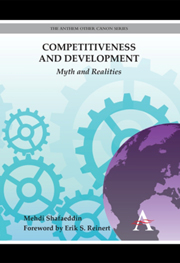Book contents
- Frontmatter
- Contents
- List of Tables, Figures and Boxes
- Foreword
- Preface
- Acknowledgements
- List of Abbreviations
- 1 Introduction: Framework of Analysis
- 2 Context and Conditions of International Competition
- 3 Alternative Theories of Competitiveness
- 4 Firm Strategy and New Industrial Organization
- 5 External Economies: Organization of Interfirm Relations
- 6 Reputation and Trust: A Firm's Relations with Stakeholders and Others
- 7 Innovation and Upgrading
- 8 Government Policies
- 9 The Experiences of China and Mexico
- 10 Summary and Concluding Remarks
- Appendices
- Bibliography
- Index
10 - Summary and Concluding Remarks
Published online by Cambridge University Press: 05 February 2013
- Frontmatter
- Contents
- List of Tables, Figures and Boxes
- Foreword
- Preface
- Acknowledgements
- List of Abbreviations
- 1 Introduction: Framework of Analysis
- 2 Context and Conditions of International Competition
- 3 Alternative Theories of Competitiveness
- 4 Firm Strategy and New Industrial Organization
- 5 External Economies: Organization of Interfirm Relations
- 6 Reputation and Trust: A Firm's Relations with Stakeholders and Others
- 7 Innovation and Upgrading
- 8 Government Policies
- 9 The Experiences of China and Mexico
- 10 Summary and Concluding Remarks
- Appendices
- Bibliography
- Index
Summary
Trade, [and] thus international competitiveness, are means to development; they are not an objective per se… Nations may have different objectives than maximizing world welfare.
(List 1856)Analysing the interrelation between competitiveness and development in this book we have argued that there are two different approaches to competitiveness: static and dynamic, with different implications for long-run development of a country. The static approach is based on the static version of the theory of comparative cost advantage and keeps the pursuing country at a low level of development. The dynamic, or Schumpeterian/ Listian, approach will lead to competitiveness at a high level of development. The static approach is advocated by the proponents of neoliberalism while the dynamic approach is propagated by ‘neodevelopmentalists’.
The main developed countries set targets closely, at the highest level of their executive machinery, i.e. in the presidents’ or prime ministers’ offices, and draft and implement strategies and policies for achieving competitiveness at a high level of development. Yet they try to impose a static approach to competitiveness on developing countries, either directly or indirectly, to limit their policy space. They do so directly through bilateral or regional trade agreements and EPAs, and indirectly though international organizations such as international financial institutions and the WTO.
Following Reinert (1995, 26) we have regarded competitiveness as an element of development. In this sense of the term competitiveness refers to activities, which, while ‘being competitive’ in the micro sense, also contribute to value added and development, raising income and improving the standard of living of a nation's population.
- Type
- Chapter
- Information
- Competitiveness and DevelopmentMyth and Realities, pp. 259 - 274Publisher: Anthem PressPrint publication year: 2012



